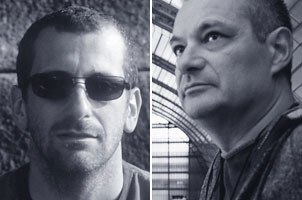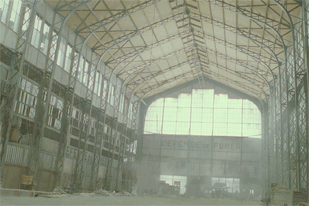Alain Bielik chronicles how previsualization helped director Jean-Pierre Jeunet bring his epic WWI romance, A Very Long Engagement, to the silver screen.

In the last five years, previsualization has become a major tool for American filmmakers, but in France, the technique is still used scarcely. Even the most high-end projects tend to be planned the traditional way: via storyboards. Such was Jean-Pierre Jeunets plan for his latest epic, Warner Bros. A Very Long Engagement, the story of a young woman (Audrey Amélie Tautou) who searches for her lost fiancé in the turmoil of the first World War. As always with the celebrated director, the entire movie had been storyboarded, but the complexity of some sequences stretched the limits of the technique.
Indeed, when Jeunet enlisted his long time effects provider Duboi in Paris, visual effects supervisor Alain Carsoux suggested the use of previsualization for at least one sequence. Known as the blimp sequence, this complex series of shots included a blimp blowing up in a hangar after a bomb hit. Everybody was concerned about this sequence, Carsoux recalls. We were all wondering how we could shoot it on a reasonable budget. The blimp was supposed to be 100 feet long. How could we build it? What kind of structure was necessary to support it from above? How could this huge set be lit? How many extras did we actually need? There were so many questions to answer. Of course, there were solutions for every problem, but at what cost? The more we explored it, the more it looked like Ben-Hur!

Carsouxs approach for the sequence was to use a CG blimp instead of a full-size set element. However, Jeunet was worried that a digital blimp wouldnt look real. Carsoux suggested a compromise: the blimp would be digital, but the blast itself would be created with a miniature (built by the special effects coordinator team of Les Versaillais) and combined with the CG model for the actual explosion shots. Another cause of concern for the filmmakers was the fact that the sequence kept increasing in scope. In the first draft of the script, it was already planned as a major action set piece, but it progressively became the most extensive action sequence of the whole movie.
Under such circumstances, Carsouxs suggestion of planning the sequence via 3D previsualization met a very positive response from Jeunet and the producers. Jean-Pierre is usually not very keen on 3D, but he realized that previs allowed him to anticipate the actual shoot with a level of detail that was impossible to achieve with traditional hand-drawn storyboards. For their part, the production people thought the investment would pay off handily by allowing them to precisely break down the actual cost of plate photography.

State of the Art Tools
Once the previs concept had been approved, Carsoux took his team to the hangar that had been selected for the location shoot. They measured every dimension of the building using a Leica geometer tool. They also took hundreds of reference photographs of the location. Since the building was not going to be reproduced in CG on screen, there was no need for a laser scan of the location. Back at Duboi, CG artists used Maya to build a 3D replica of the hangar. Maya may seem like a `heavy software for simple previs work, Carsoux admits, but I thought it offered many options down the road. Plus, all our CG artists are Maya savvy and the effects shots would later on be realized in Maya anyway. So, it made sense to use this one software for the whole modeling and animation pipeline. The compositing was to be done in our proprietary software Dutruc.
Photographs of the actual building were used as texture maps to dress up the digital walls, floor and ceiling, producing a realistic recreation of the real hangar. This digital set was then filled up with a 3D replica of every single prop, vehicle and character. Contrary to the set itself, these elements would remain non-textured in the previs. I thought that a realistic background would allow Jean-Pierre to precisely work out the framing of the shots, Carsoux comments. He could get a much better sense of the action than if the whole image had been made of simple 3D geometries.
Dubois previs team started to block out the shots using the storyboards as a basis. Then, Jeunet came in to give his personal input, choosing lenses, placing the camera, designing crane moves and framing the shots. He really directed the scene as if it would have been a real set, except that it was all made on a computer, Carsoux comments. Since every prop and set element blimp included had been digitally reproduced, he could see what worked and what didnt work, how far the camera could go a certain way, what were the best ways to frame the blimp. At the same time, he acted out the whole sequence, playing all the characters one after another, detailing body language, facial expressions, etc.

Expanding the Concept
Originally, the goal was to previsualize any shot that required visual effects, but Jeunet and Carsoux noticed that, in some instances, it wasnt enough. When the action cut from an effects shot to a live-action shot back to an effect shot, the filmmakers couldnt see if the progression was working with this missing shot. Very quickly, Duboi started to generate previs for non-effects shots too. It just came out of the necessity to previsualize the sequence as a whole, not as a succession of individual shots, Carsoux observes. Week after week, we kept adding non-effects shots until we basically had the whole sequence previsualized! Along the way, some artists started to animate eye lines, another added a little hat onto the nurses head and others blocked out characters facial expressions Little by little, without us really noticing, the amount of detail in the animation and the modeling grew exponentially. Everybody seemed to take personal pride in having a direct input in the previs!
All the shots were previsualized in their entire length, without any concern for editing or rhythm. The whole sequence was then delivered to Jeunet as a DV file that the director edited on his Macintosh using iMovie.


Matching the Previsualization
Weeks later, the crew went back to the hangar for principal photography. Duboi used the Leica geometer system to locate on the real set the position of the digital camera in each previsualized shot. The set-ups were further fine-tuned by lining up the actual framing with the previs image, thanks to a video switch tool provided by Cinesoft. Once the previs framing had been matched, Duboi combined the live-action video output with a CG blimp, allowing Jeunet to get a very close look at what the final composite will eventually look like.
Most of all, this on-set compositing system helped us determine exactly how many extras were necessary for each shot, Carsoux notes. Without it, we might have placed extras in locations that would eventually have been covered by the blimp. It turned out to be very economical for the production since we knew in advance how many extras were really necessary and where they should be positioned. Jeunet faithfully reproduced the previs for the effects shots, but used it merely as a guide when capturing regular shots with actors.
For each approved take, Duboi did a temp composite with the CG blimp and delivered the shots to the editors. As the shooting progressed, the approved shots were cut in with the previs, replacing their digital equivalent until the whole sequence had been captured on film.


Simulating a 3D Move in 2D
Four other sequences required previsualization, but in each case, the technique was used in a single effects shot. The most challenging of these shots featured a crane move on the Opera House plaza in Paris: the camera frames the Opera House, then goes down into a building in the foreground. Since the action was supposed to take place in the early 20th century, extensive visual effects work was required to recreate the proper imagery.
Initially, Jean-Pierre had designed a camera move that obliged us either to use motion control or to build a CG replica of the Opera House, Carsoux recalls. It also necessitated motion control to shoot the extras too. I started to look for a way that would allow Jean-Pierre to create the same impression in a much more cost-effective way. To this purpose, we recreated the location in CG and previsualized the crane move. We calculated the maximum range of the camera move that would still allow us to create the shot without either motion control or CGI.
Jeunet took advantage of the previs to choreograph the action in the street. This establishing shot was to feature dozens of extras, horses and period cars, all mixed up in the complete mess that traffic was back then. Jean-Pierre used the previs to precisely time the movement and direction of the major elements, trying to get an interesting and lively feel to the scene. He would ask us to add a car here, drop an extra carriage there, slow down this vehicle move, etc. He then reproduced this choreography with the extras during principal photography.
Thanks to the previs, the Opera House plaza was ultimately shot static, as were the extras photographed at a different location in four separate passes. The only camera move was executed manually on a partial building set erected in front of a bluescreen. Duboi merely blocked out the start point and the end point of the move, making sure it didnt exceed the range that had been determined. After the Opera House plate had been cleaned up from any anachronistic element, the different plates were combined in Dutruc. 2D artists used pinning technique to distort the static elements in order to create the illusion of a perspective shift. Ultimately, this complex multi-element tracking shot was entirely realized in 2D.
The Cinema of the Future
Altogether, Jeunet was thrilled by the possibilities of previsualization. He realized that the complete, edited sequence basically existed before any frame had been shot, Carsoux concludes. Once, Audrey Tautou came in while Jean-Pierre was working on the previs. He told her: `look, this is the cinema of the future. I could even film from my bedroom! And then, teasing her, he told the animator: `OK, so now, take (synthetic) Audrey and make her go over there. Give her a larger smile Getting the point, Audrey answered: `By the time youre able to direct me on the computer, Ill be directing movies with an off-the-shelf software in which there will be the option: Make your movie à la Jean-Pierre Jeunet!
Alain Bielik is the founder and special effects editor of renowned effects magazine S.F.X, published in France since 1991. He also contributes to various French publications and occasionally to Cinefex. Hes currently organizing a major special effects exhibition that will open next month in Lyon, France.








